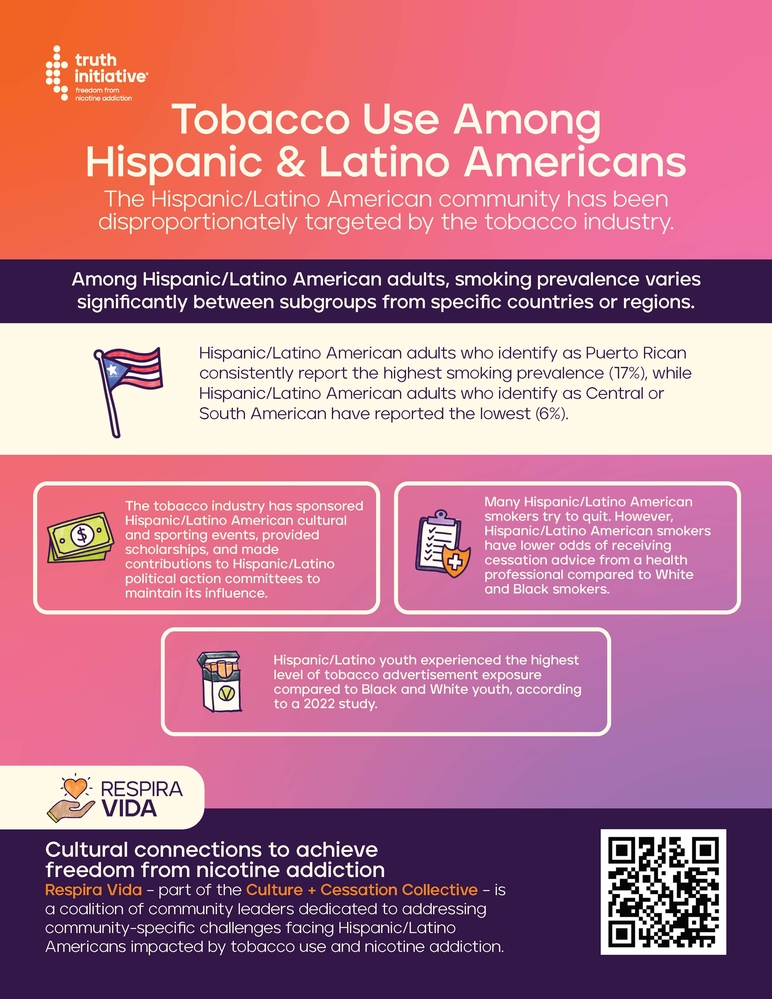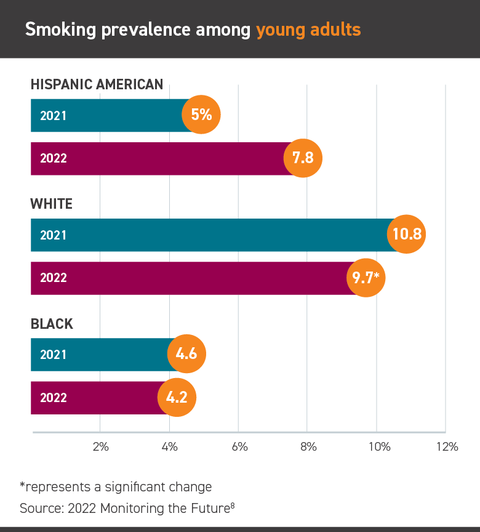Tobacco use among Hispanic and Latino Americans

Individuals who are Hispanic or Latino comprise 19.1% (63.7 million) of the U.S. population, according to the 2022 Census. While the latest data on smoking prevalence among adults indicate that 7.7% of Hispanic adults in 2021 smoked cigarettes — lower than the national prevalence of 11.5% — studies have shown smoking prevalence varies significantly between subgroups from specific countries or regions. Among all Hispanic American adults, those with Puerto Rican origin had the highest smoking prevalence and those with origins from Central or South America had the lowest smoking prevalence in 2019, the most recent year data are available. U.S. -born Hispanic Americans face higher cancer risk compared to those in their country of origin due to the adoption of behaviors such as smoking. E-cigarettes are the most commonly used tobacco product among Hispanic American middle and high school students, who have about the same prevalence of cigarette and e-cigarette use as middle and high school students overall.

E-cigarettes are the most commonly used tobacco product among Hispanic American middle and high school students.
PATTERNS OF USE IN THE U.S.
HISPANIC/LATINO YOUTH
- Hispanic high school students have the same cigarette smoking prevalence as high schoolers overall (2%), according to the 2022 National Youth Tobacco Survey.
- Hispanic American middle schoolers continue to have a slightly higher prevalence of cigarette smoking compared to middle schoolers overall (1.2% v. 1%).
- In 2022, e-cigarettes were the most commonly used tobacco product among Hispanic American middle and high school students (8.8%), followed by cigarettes (1.8%) and cigars (1.7%).
- Hispanic American high school students reported slightly lower prevalence of e-cigarette use compared to high schoolers overall (12.2% vs. 14.1%) in 2022, while Hispanic American middle school students reported a slightly higher prevalence of e-cigarette use compared to middle school students overall (4.2% vs 3.3%).
HISPANIC/LATINO ADULTS
Hispanic American adults have a lower prevalence of all tobacco product use compared to adults overall, according to the 2021 National Health Interview Survey. This includes cigarettes, cigars, pipes, e-cigarettes, and smokeless tobacco products. However, smoking prevalence differs widely within Hispanic subgroups and by gender:
- Hispanic American adults who identify as Puerto Rican have consistently reported the highest current smoking prevalence (17%) compared to other subgroups, whereas Hispanic American adults who identify as Central or South American have reported the lowest (6%).
- Adult Hispanic women have reported significantly lower smoking prevalence (6%) compared to Hispanic men (12%).
- In 2022, 7.8% of Hispanic young adults reported that they smoked cigarettes in the past 30 days, lower than White young adults (9.7%) but higher than Black young adults (4.2%), according to the Monitoring the Future Report. Compared to 2021, smoking prevalence for Hispanic young adults in 2022 trended upward, while smoking prevalence among Black and White young adults trended downward.
- Among Hispanic adults, 3.3% used e-cigarettes in 2021 compared to 4.5% of adults overall.
- Between 2016-2017, 53.2% of Hispanic smokers had made a quit attempt. However, Hispanic smokers had lower odds of receiving cessation advice from a health professional compared to White and Black smokers.
HEALTH EFFECTS OF SMOKING
- In 2019, heart disease was the primary cause of death among Hispanic Americans (24.9%) followed by cancer (20.3%). Smoking contributes to heart disease, and use of smoked or smokeless tobacco can cause 12+ types of cancer and makes up ~40% of cancer diagnoses.
- Lung cancer is the most common among these cancers, yet Latino men and women have a 70% lower risk of having lung cancer compared to other racial/ethnic groups.
- Hispanic/Latino Americans are at an increased risk (~1.5-2%) of contracting and dying from stomach cancer, along with Americans that identified as Black, Asian, and Hawaiian/Pacific Islander.
- Puerto Rican and Cuban Americans have higher prevalence of colorectal cancer compared to their counterparts in Hispanic/Latino countries.
- Following American Indian/Alaska Natives, Hispanic/Latino Americans have high prevalence of liver cancer.
- In Texas, cancer death rates in U.S.-born Hispanic men were 61% higher than those in foreign-born Hispanic men during 2008-2012 and only slightly lower than those in White men, largely driven by differences in lung cancer death rates.
INDUSTRY MARKETING
Tobacco companies have a history of targeting racial and ethnic minorities, including the Hispanic/ Latino population. Big Tobacco developed interest in the growing Hispanic population and launched marketing initiatives in the 1970s and 1980s. Internal documents revealed the tobacco industry deemed the population “lucrative,” “easy to reach,” and “undermarketed.” The industry has sponsored Hispanic/Latino cultural and sporting events, provided scholarships, and made contributions to Hispanic political action committees to maintain its influence. Today, we see that Hispanic Americans have high exposure to tobacco ads as well as high prevalence of flavored tobacco use:
- Hispanic youth experienced the highest level of tobacco advertisement exposure compared to Black and White youth, according to a 2022 study. Schools with larger Hispanic and “economically disadvantaged” populations have greater exposure to tobacco-related advertising around school compared to those with a smaller Hispanic student population.
- The Hispanic/Latino population is especially at risk of flavored tobacco product use. Hispanic and Black populations have higher rates of menthol product initiation compared to their White counterparts. Hispanic youth had the largest increase in flavored tobacco product use (30.3%) over a 30-day period and were the most likely to vape in the future (42.3%), according to the 2019 National Youth Tobacco Survey.
- Online marketing is also a concern, with Hispanic American (23.4%) and Black American (26.2%) adolescents having higher engagement with online tobacco marketing compared to their White adolescent counterparts (22.3%).
More in targeted communities
Want support quitting? Join EX Program
By clicking JOIN, you agree to the Terms, Text Message Terms and Privacy Policy.
Msg&Data rates may apply; msgs are automated.




